#literary analysis
Text
Pros of reading authors you don't agree with:
You can make informed rants about how wrong they are.
A+ practice for learning to read texts critically and thinking for yourself, even among people you do agree with.
Occasionally, begrudgingly, they may have a point.
Even if they don't, being able to articulate why helps you understand your own beliefs and spot errors in your thinking.
You'll be much more persuasive to the other side if you understand their arguments and aren't just making assumptions based on what you've heard from others.
Academic drama is incredible.
76 notes
·
View notes
Text
hang on I have to rant
if you're not already aware, the five-man band is a literary device used to classify teams of 5 characters. it's what I call an external trope, meaning that you fit the trope to the characters, they don't innately have it.
a:tla has a pretty solid one, and it's well known enough, so I'm gonna use it to show you what I mean
it is comprised of:
the Leader, who directs the group and is usually the main character (aang)
the Lancer, who serves as character foil to the Leader and is often a bad-guy-turned-good or rogue element (zuko)
the Big Guy, who solves physical problems for the team and is frequently a goofball (toph)
the Smart Guy, who solves technical/logistical problems for the team and typically serves as an "idea guy" (sokka)
and the Heart, who solves emotional problems for the team- if there's only one girl, she's probably the Heart (katara)
there are three star wars groups I want to look at: delta squad, domino squad, and clone force 99.
first is domino squad, as they fit this trope the easiest.
fives is the Leader, the most strategizing one in the group
droidbait is the Lancer, far less cautious and more prone to injury than the others (the foil to fives' effectiveness)
hevy is the Big Guy, serving the oh-so-common "big gun demolitions expert" variant
echo is the Smart Guy, in the "guys, come on, stick to the PLAN" variant
cutup is the Heart, lightening the mood with jokes (hence the name)
the first to die is droidbait, leaving echo to serve as fives' foil, which allows us to see that fives is probably the most prototypical clone of the bunch. then hevy sacrifices himself, and cutup gets eaten, leaving only fives and echo until the Citadel arc which I haven't yet seen.
then we have delta squad. the thing about delta squad is that there are four of them, and while the four-man band is a thing, they make this perfect incomplete five-man band that I think is really really tasty.
boss (player character) is the Leader, guiding the team
sev is the Lancer, playing the "snarky rogue" archetype
scorch is the Big Guy, again the "big gun demolitions" variant- but with the added flavor of being very by-the-book (which we see the consequences of when he aligns with not only the empire but doctor hemlock himself in tbb)
fixer is the Smart Guy, tech expert
notice anything?
there's no Heart.
and that works. these are clone commandos- meant to be the most effective troops the republic has. they almost never interact socially outside of their squad, and when they do it's kept pretty professional.
we see that again in clone force 99, or as they call themselves, the bad batch
hunter is the Leader, his enhanced senses leaving him the most generalist of the batch (and also he's technically their sergeant)
crosshair is the Lancer, a "silent, ruthless efficiency" type
wrecker is the Big Guy, "big gun demolitions" variant yet again (I told you it was common) in the goofball flavor
tech is the Smart Guy, btw he's really well done and it never feels like he just "knows because he's smart" you can always tell how he figures things out
again, there's no Heart. but wait.
in the Bad Batch arc in clone wars, they pick up another member- echo. we don't see much of echo's interaction with the batch in that arc, but when we come back, echo is solidly in a sort of almost-but-not-quite Heart role. and then.
omega shows up in the "sixth ranger" role, there to shake up the group dynamic. throughout season one, we see omega slowly take over echo's role as Heart- and as this happens, it becomes clear that that was the role he was playing, as he talks hunter through how to best take care of omega. but omega, tagalong kid as she is, is much, much more suited to the Heart role than echo, and she takes his place- which allows echo to run off and have his own adventures with rex throughout seasons two and three, WHICH WORKS because echo is a regular clone who joined the batch later in life and thus isn't quite the same as the others, but omega is a deviant clone just like them!
#tbb#nerdipost#original post#star wars#the bad batch#star wars the bad batch#sw#sw tbb#clone force 99#star wars the clone wars#domino squad#delta squad#tbb star wars#star wars republic commando#republic commando#swrc#swtbb#swtcw#sw the bad batch#sw tcw#the clone wars#literary analysis#5-man band
57 notes
·
View notes
Text
A Discussion Of LavenderTowne and Hazbin Hotel
So, a little while ago, a YouTube channel called LavenderTowne ventured into the Hazbin Hotel fan space to propose some criticisms and fan redesigns of the characters.
I had thoughts on the original video, but those are irrelevant because its reception was… tumultuous, and in my opinion disproportionate. The video has since been taken down, and LavenderTowne uploaded a follow up to it (link). In which she stated that her experience with the Hazbin Hotel fandom wasn’t the most pleasant, something I would like to address.
So, this post will be an academic discussion of the designs from the second video. Because I think her criticisms were interesting and because I want to show that it is possible to disagree with someone without being unpleasent.
Also, I want to give LavenderTowne a more welcoming experience with the fandom, and try to make up for some other members of the community.
Let me explain.
SPOILERS AHEAD (Hazbin Hotel)

I'm going to start with something that needs to be said. You can disagree with the rest of my post, but this is non negotiable:
It is never, under any circumstances, acceptable to harass someone for their opinions, especially about art. I don't care if you take issue with conclusions or perceived motivations, actions like I observed are not ok, and are not welcome in this fandom.
I hope I made that clear.

Anyway, I am going to be addressing the second video, because LavenderTowne took the first down, and I'm not about to intrude where I'm not wanted.

LavenderTowne mentioned the overarching stylistic choices, and I think that is a good place to start with this post, because they are good source of difference. Several of LavenderTowne’s criticisms are leveled at the Hazbin Hotel visual style itself, discussing what specific elements didn’t work for her and how she would personally draw things differently.
That is what I want to discuss here. Rather than the specifics of artistic technique, I am going to talk about the character design decisions brought about by the difference in style. This isn’t a question of skill, but an examination of the ideas presented.

Both LavenderTowne’s style and that of the Hazbin Hotel team range on the scale of realism, as is the nature of art, and that has caused a few of the design decisions that they have made. But it has also had a weird effect on the implied plot that is worth discussing.
Hazbin Hotel is more cartoony, for example, which means its logic is a bit more fluid. Vaggie's eye scar, for example, is shown over her hair, which isn’t how scars work in the real world.
This is a way of getting the tone across. Sir Pentious, at one point in the series, gets caught in the blast of an explosion and sent flying across the city. The design style lets you know that this is being played for a laugh and that he will probably be fine. If LavenderTowne had drawn Sir Pentious in her style, I guarantee that version of him would not survive the event, because hers is grittier (that’s the wrong word, but you get the point).
I do, however, really like the colour palette shift in LavenderTowne’s designs. Don’t get me wrong, I like the limited palette of the actual show, and I think it suits the setting more than the pastel aesthetic of LavenderTowne’s style.
But, those pastel colours are gorgeous and they are a really neat way of solving one of the problems that LavenderTowne identified and I agree with, that being how difficult character differentiation is when everyone has the same colouration as each other and their background.
Now, neither of the two options are implicitly better, there is just a different design sensibility going on.
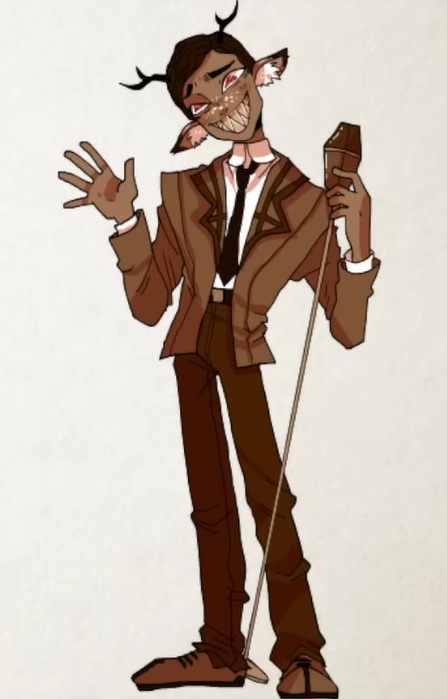
As for the designs themselves, I actually prefer LavenderTowne’s Alastor over the original. I would like to see how it interacts with Alastor animation and transformation, but I think the design overall works better for the character. I like the horns being more pronounced, and I like that neat hairstyle. I think it's much more suited to an overly refined character who revolves around appearances.
“Just because you see a smile, don’t think you know what’s going on underneath. A smile is a valuable tool, my dear! It inspires your friends, keeps your enemies guessing, and ensures that no matter what comes your way, you’re the one in control.”
I think that Alastors original hair style is more about looking cool than looking refined. The shorter style, combined with the more prominent antlers, gives that air of someone actively concealing their more wild undercurrents.

That being said, I'm not as sold on Alastor's expression in LavenderTowne's design. This is a stylistic choice, but I don't think that the Cheshire Cat smile translates over to the alternate design as smoothly as his concept. In the original, that smile was the thing that denoted him as malicious, but LavenderTowne's design seems more huggable, at least to me.
LavenderTowne did raise an interesting point about the voodoo symbolism, a point that others have raised, and I think is worth noting. Incorporating that aesthetic as synonymous with dark magic in a setting based heavily off Christianity is funky, thematically. It's a use of stereotypes as shorthand, which carries the baggage of those stereotypes, intentionally or not. However, I am about as far from qualified to talk about this in detail as possible. I recommend that you listen to the opinions of people who know more about this than me, and who's case this is to make.
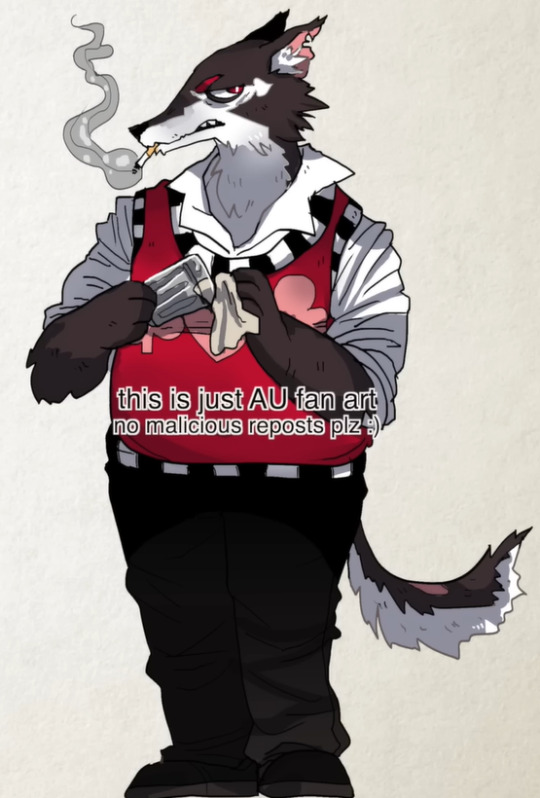
Husk’s design is another that I like, but this one I have slightly mixed feelings about. The body type change addresses another of LavenderTowne's criticisms of the series, again in relation to character differentiation. That is a strength of the video, LavenderTowne gives criticisms, and explains what she means and how she would go about doing it.
Interestingly, that body type issue is something I disagree with. I think the way that LavenderTowne has handled the issue she identified is fascinating, and one of the best parts of her process. But this is simply an issue I don’t see as a problem.
The criticism is that the silhouettes of the characters are exceedingly similar, meaning that identifying them is difficult, as well as limiting in terms of variety of proportions. I could point out Sir Pentious or Husk here, but that is arguing in bad faith because Husk is very clearly the exception to the rule, and Pentious actually conforms to her observation. Without his hood out, Pentious’ silhouette difference is in his tail, which is rarely onscreen.

The reason I am ok with this, is that Hazbin Hotel has a thing for transforming character designs. Charlie, Valentino, Emily and Serah, Lucifer, even Adam, Vaggie, and Lute, as well as a ton of others. All of these character designs shift as the story progresses, revealing aspects of them that they have kept secret. I like having the baseline similarities if everyone gets a moment where they show off how different they are from that baseline. I think that is a cool story beat that, for me at least, outweighs the problem of similarity. I’m sure LavenderTowne would disagree with me here, and that is more than fine.

Back to the point, Husk is a character who is surprisingly acrobatic and martially competent, and the slight shift in the alternative design switches him into more of a bar brawl type character. This feels like the guy who would just deck you and tell you to cool off, rather than throw something at you. He looks like the type of bartender he is, cool and calm, and ready to offer advice when needed.
The removal of the wings is an interesting choice. On the one hand, it clears up his design and makes him look more down to earth. On the other hand, it leads into my main bugbear with this design. I don't think this version of Husk looks like an overlord.

This is subjective, and I am struggling to quite explain it. But the wings, as well as his voice, give a sense of gravitas to Husk. Without that, Husk looks relatively unremarkable.
The outfit plays into this. While I prefer it and its subtlety, there is little that marks this version of Husk out as higher ranking.
Again, this isn't a case of the original designs being objectively better. This is a different design that communicates different things. LavenderTowne’s Husk is a humble bartender rather than an overlord playing pretend. I simply like the story that the original offers more.

Vaggie’s new design is both my favourite design of the four, and the one that is the furthest from the story of the show.
I love the quieter eye scar, I love the silhouette, and I think moving the ribbons to her back is a genius bit of visual storytelling.
The outfit is cool (I especially like those boots), but there's an asterisk to that, because I don't think it entirely suits Vaggie as she is presented in the show.
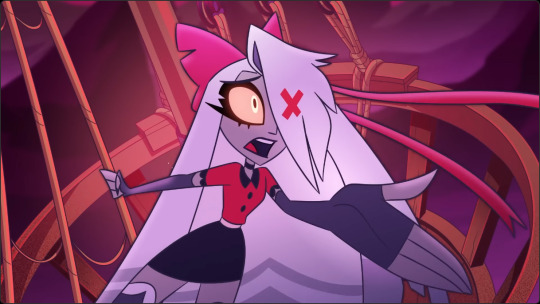
At the risk of oversimplifying, Vaggie is a fairly uncomplicated character. Not because she's written to be shallow, but because the show doesn't have time to explore her personality.
So, you get her past, which is fascinating, and it leaves some interesting things on the table.

For example, Vaggie has zero self preservation instinct and will burn herself to the ground for Charlie. This isn't complex, but it's remarkable how much the writers (and animators if you’re looking for that kind of thing) get out of this one detail.
Most notably, her character grows into realising that love means living for someone rather than dying to keep them safe. This culminates in the defeat of Lute, the embodiment of her past, who doesn't think to move out of the way of a collapsing building.

Similarly, Vaggie was an angel and wants to hide that aspect of herself. This makes her multifaceted in backstory, but the reveal doesn't have time to dwell on her characterisation, so it just feeds into what I said before.
I think that with another season of time to develop, Vaggie’s characterisation will become as complex as her backstory. But that doesn’t come quickly.
The point I am making is that I don't think this version of Vaggie would wear armour until the end. She doesn't think she can get killed, so why would she need to protect herself?
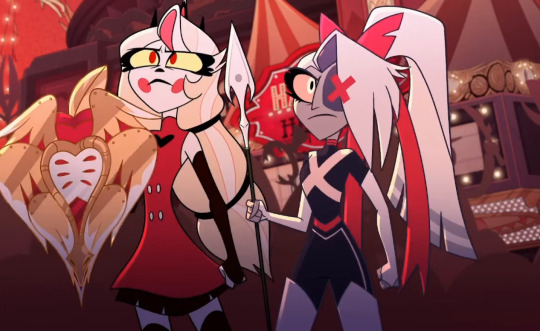
Which means that LavenderTowne's design would work for the last episode of the show, if it had wings, which is sacrificing the single best piece of foreshadowing I have seen in a long time. Seriously, I cannot stop gushing about those ribbons.
What we have, then, is a version of Vaggie with a slightly different story and personality. To me, LavenderTowne's Vaggie looks like a character who craves safety. She seeks Charlie because she offers emotional stability and kindness, the one person in hell who Vaggie doesn't think is against her. But she would wear the armour and outfit because of the injury. She realises she can be wounded and grabs the heaviest set she can find, the twin coloured trousers come from that desperation, and add to the imbalanced aspect of her design.
This version of Vaggie is defensive rather than offensive, and though it renders Out For Love obsolete, I find it more interesting than the original.

Charlie's design, however, I'm not such a big fan of. I'm sorry LavenderTowne, I really am. But this design really doesn't sit right with me.
Hazbin Hotel has a circus theme going on. The main foyer has a circus tent affectation, for example, and Charlie gives off the aesthetic of the ringmaster.
Charlie is very overtly the antithesis of a Disney princess, and that comes across in her design. Instead of wearing a floaty dress, she wears a suit and suspenders.
Yes, the hooves and horns being more prominent is a cool alteration that I appreciate, but the alternate outfit really doesn't feel like Charlie.

I think the difference is in the framing. To me, LavenderTowne's Charlie comes across as naive and optimistic, where the original design is more relentlessly hopeful, and that second one matches how she is in the series.
Charlie in Hazbin Hotel showcases true hope. Not optimism, hope. The type of emotion that keeps getting knocked down, but picks itself off the floor ever single time, and gets ready to try again. Charlie has no proof of her philosophy, no basis. She's not trying to recreate phenomena, she doesn't even know she can succeed. That's why she needs the hope.
I don't think that LavenderTowne's design has that vibe. Instead, this Charlie seems younger, which contributes to the naivety. It feels like it leans into her regular design, so the more fearsome transformation comes as a shock, mostly.
On the other hand, the three horn tiara element is genuinely really cool. It gives that air of reality, and hints at the transformation without giving it away. They round out the design and make the “this is a demon princess” clear.

Interactions between this Charlie and Adam, Lute, or Sarah would be interesting, as this version seems designed to foil off them, rather than the other way around. Especially Emily, this design seems genetically engineered to mirror her and make her question her ideals just through existing in the same place.
In short, this Charlie seems more gentle than the original, which might help in some aspects, but I prefer the original.
One again, this is my opinion, and not objective by any stretch of the imagination. If you disagree with me, good, that's the bread and butter of how analysis and discussion exists. But I hope I have shown that disagreement is possible without aggression.
Which brings me to my conclusion, and I have something here that I hope you will like.

LavenderTowne's designs feel like they are made for the same story, but paced differently. They feel like a different style of musical. They feel like they were made for a version of Hazbin Hotel that had more episodes and has time for subtlety, something that the original show unfortunately didn't have.
The story feels the same, but the minour changes make it seem more drawn out. The tone is different, and that effects the entirety of the rest of the story.
In other words, she is designing an AU, something she makes explicitly clear at least five times in her video.
LavenderTowne mentioned in her video that she might do a follow up with a few more characters. I would be intrigued to see this, because I want to know what Angel Dust would look like in this version of the story, as well as the actual angels and even the Vees.
I also am fascinated by how the art style affects the tone of the story. And with LavenderTowne's permission, I might have a crack at writing some of the key scenes from the show to fit this aesthetic and tone. I think that would be an interesting thought experiment.

Final Thoughts
LavenderTowne’s designs were dope as all hell, and the points she raised were worth discussing.
I love the series, but I understand that it's not everyone’s cup of tea. Content warnings should get that across, but also some people just won't like elements of it for any number of reasons, and that is ok.
I think @ohnoitstbskyen put it best in his discussion of the finale of the series. (Link). In his closing remarks, he spoke at length about people who will discover the show and the effect that it will have on them. That sentiment, boiled down, became the title of that video, and concisely says what I have taken just under 3000 words to talk around.
“This show will save someone’s life, but it isn’t for everyone.”
But let me be clear about why I wrote this.
I saw some of the shit that people wrote about LavenderTowne's original video, and though a lot of it was positive, a fair chunk was not, and I want to put my foot down. Disagreement about art is healthy, but if you think that involves harassment at all, then tell Husk he still owes me a drink.
On a lighter note, this is my first post about Hazbin Hotel, so for those who are reading my stuff for the first time, hello. I am Ari, I do media analysis, and I plan on doing a series on Hazbin Hotel, going through each song with lyrical and musical analysis once I finish my current one on Wicked. So, if that interests you, maybe stick around.
#rants#literary analysis#literature analysis#what's so special about...?#character analysis#hazbin fanart#hazbin hotel fanart#hazbin hotel#hazbin alastor#hazbin charlie#hazbin vaggie#hazbin husk#lavendertowne#I will write for this AU if LavenderTowne lets me
20 notes
·
View notes
Text
Rereading the Lord of the Rings series recently, and it's so fascinating to me how much the series is a denial of the typical juvenile power-fantasy that is associated with the fantasy genre.
Like, the power-fantasy is the temptation the Ring uses against people It tempts Boromir with becoming the "one true king" that could save his people with fantastic power. It tempts Sam with being the savior of Middle Earth and turning the ruin that is Mordor into a great garden. It tempts Gandalf and Galadriel with being the messianic figure of legend who brings salvation to Middle Earth and great glory to herself.
The things the Ring tempts people with are becoming the typical protagonists of fantasy stories that we expect to see. and over and over we see that accepting that role, that fantasy of being the benevolent all-powerful hero, is a bad thing. LotR is about how power, even power wielded with benevolent intent, is corrupting.
And its so fascinating how so much of modern fantasy buys into the very fantasy LotR denies. Most modern fantasy is about being that Heroic power-fantasy. About good amassing power to rival evil. But LotR dares not to. It dares to be honest that there is no world where anyone amasses that power and remains good.
I guess that's one of the reasons its so compelling.
#Lord of the Rings#LotR#lotr#literature#fantasy#literary analysis#analysis#Galadriel#Gandalf#The One Ring#Sauron#Sam#Samwise Gamgee#Boromir#Gandalf the Grey#Gandalf the White
4K notes
·
View notes
Text
There is no easy way out of learning to be literate when it comes to fiction.
You cannot say "An author is never what they write".
You cannot say "An author is always what they write".
Authors who are completely normal people with healthy understandings of every dark topic in our work can write extremely fucked up shit about topics including bigotry, rape, you name it. If you think writing about those topics at all is "glorifying" it, then you will falsely believe those authors are horrible people.
But horrible people can actually be authors - and sometimes they hide their horribleness in ways you can't recognize. Sometimes they don't - sometimes they are just fully and openly bigoted.
But if you can't tell the difference between "A story that has fucked up shit in it because those things fit the mood, motifs, message, or genre" vs "A story with fucked up shit in it because the author thinks those things are morally good", you are going to fucking struggle in life and you will in fact be very susceptible to bigoted propaganda.
And no, I won't sit here and say it's always easy to tell the difference. But with practice, you can in fact tell the difference between a story where the author is writing about the main character being ravaged and raped in a sexy way because it's a safe way to explore that fantasy, VS, an author who clearly just thinks women should be raped and subjugated because that's their actual worldview.
That can involve examining the individual piece of media, other things that author has written, who the author is, etc.
2K notes
·
View notes
Text
I've been thinking about the fact that some readers of Sense and Sensibility don't believe Willoughby truly loved Marianne, even though everyone in the book believes it and the narrator makes it clear how much he cared for her, at the end. And I think this reading of him takes away from one of the messages of the book, which is that love is not enough.
Willoughby loves Marianne, but that's not enough to stop him from hurting her, it's not enough to make him give up his cushy lifestyle and marry her, and it wouldn't have been enough to keep him happy with her long-term. Marianne loves Willoughby, but it wouldn't have been enough for her to be happy with him long-term either.
Edward loves Elinor, but that's not a good enough reason to break his promise to Lucy, because integrity and honor and responsibility are just as important to him. Brandon loves Marianne, but that's not reason enough to court her, because he knows her feelings lie elsewhere and she doesn't respect and esteem him yet.
Love is important to all these characters, and is a vital part in making the marriages that they ultimately end up in strong and happy, but it's not the only thing that makes them work.
Of course, Sense and Sensibility is hardly the only Austen novel to make the point that you need more than love or romance or passion to make a relationship work. But I think it's interesting how we get to see this play out in the villain of the novel. Willoughby does some truly horrific things, but his character shows that even really bad guys are capable of feeling love and guilt and remorse. But none of these feelings are ultimately strong enough to change him. Because love is not enough.
613 notes
·
View notes
Text

Let this be a living example that knowing the beliefs of any individual who wrote any piece of text- be it literature, articles, or posts- can and should drastically alter your perception on what the text is actually communicating, even if that knowledge has, on its face, changed none of the actual printed words. This is how application of real-world context works, and this is how it applies to any recorded medium.
It reminds me heavily of a quote from video essayist Jacob Geller, regarding the 1938 film Olympia- "It's different when Nazis do it".
Olympia is a film that, on its face, simply depicts an artistic documentation of the 1936 Berlin Olympics. But within the context of its production taking place during the Nazi regime, with its director being a well known Nazi propagandist... The way the movie fixates on the power and elegance of the human form and Ancient Greek statues quickly shifts from being completely innocuous appreciation to the worship of what is perceived as the ideal forms of the "Aryan race". Suddenly, you understand the movie not to be a pretty inoffensive documentation of a historical event, but a propaganda piece.
Understanding the time period in which something was made, as well as the setting it was produced in/for, and whatever ideologies an artist may hold and experiences they've had is absolutely critical to getting a full understanding of anyone's work. There are some things that are near completely anodyne on their face, but the revelation of what the author thinks and feels about other people and the world around them totally redefines every word on the page.
This image is such a prime example of why context matters. This opinion, laid bare, stripped of context, is both inoffensive and nonsensical. No one's ever thought it to be lame to create your own nickname... But on its own, that's a harmless kind of wrong.
... But with the addition of them being marked as Anti-Trans (red) on Shinigami Eyes, a browser extension dedicated to crowdsourcing keeping track of Trans Friendly and Transphobic creators... Suddenly, "Nicknames" doesn't mean "Nicknames" anymore. Suddenly, you realize that "Nicknames" is code for "Chosen Names of Trans People". Suddenly this isn't about thinking choosing your own nickname is lame, this is about thinking that trans people shouldn't have the right to name themselves. Suddenly it's about invalidating identities, thinking they're worth mocking. Thinking that people who identify as trans are "just trying to be cool", and that they're not actually what they say they are, because you don't get to choose your gender nickname, that's something already decided for you.
Suddenly, you realize, it's not about "being lame".
It's about Transphobic Violence.
This is why you cannot ignore when an artist, author, essayist, developer, musician- so on and so forth- is bigoted. This is why you can't ignore the context behind their upbringing. This is why you can't ignore the context behind their lived experience, their ideals, their goals, their message. Yes, it may appear innocent on its face. Yes, it may look fine stripped from the context of it being written by an inevitably flawed human being. But what's really being said here? What do those words mean... To the one who wrote them?
Context redefines Text.
Even if the words didn't change.
#this post is a bit random. not apologizing. it was just such a perfect encapsulation#i am still tagging this as homestuck because this is ultimately EXACTLY how i feel about hussie + their works. you must understand this.#its so applicable to hussie + homestuck + analysis of homestuck that it is fucking painful. PLEASE understand this. PLEASEEEE#homestuck#homestuck meta#homestuck analysis#andrew hussie#context#literary analysis#essay writing#cw nazi#cw transphobia#nekro.pdf#nekro.txt
1K notes
·
View notes
Text
emma is the villain of tgwdlm
I need to talk about this oh my god
because it's told from the hive's perspective. paul is the protagonist because he is the one who resists them but must ultimately come to accept that they're right. emma is the one who must be beaten through force.
the difference between the hero and the villain is that the hero must change, while the villain cannot. (I'm not speaking in universals here, just generalizations of how the narrative structures work that tgwdlm uses in parody.) the hero and the villain both hold a belief that represents the thematic evil; by the end of the story, the hero must undergo apotheosis, which is to say, ultimate unity with the thematic good. once this is achieved, he can defeat the villain, who represents the thematic evil completely and is incapable of change.
to the hive, "good" is unquestioning conformity to the group's ideals, specifically, singing and dancing in sync with everybody else. "evil" is refusing to sing and dance along when, clearly, you want to.
paul is the perfect protagonist because he resists song and dance, but largely because it makes him uncomfortable. getting out of your comfort zone is necessary for change! it's a good thing to let yourself go through something uncomfortable in order to come out the other side better and stronger for it. (that much is true; however, sometimes discomfort is a legitimate sign that you should stay away from something.) paul has never really tried singing or dancing, and deep down, is afraid that if he tried it, he might like it. exactly the sort of person who can be converted and used as a shining example of the hive's righteousness.
emma must be the villain because her refusal to fall in line is a choice. she can sing, she can dance, she was in brigadoon in high school and she fuckin killed it, she is even taught a whole ass song with choreography by the hive on their first morning in hatchetfield (emma's comment about how they have to sing "all the time, apparently!" and zoey's implied presence at the theater when the meteor hit - because she was with sam, and sam was there - strongly suggests that nora and zoey were zombified all morning and she had no idea). it's stated by hidgens and suggested by nora and zoey that getting a human to sing/dance along with them is supposed to be a sort of mesmerizing tactic that the hive uses to start synchronizing a person to the hive mind, but emma refuses. she sings and she dances, just like they want, but she chooses to actively hate it the whole time, on principle. she can't be convinced; they have to swarm her, surround her on all sides. let it out is meant to win paul to their side; inevitable is just to gloat.
in the bar scene in hidgens' bunker, emma says that she must be the villain to paul's hero because she was in the musical that got him to hate musicals. on the one hand, she had it backwards; she's the villain because according to the hive, the all-encompassing narrative power, he's not supposed to hate musicals. on the other hand, she's kind of right: paul is the protagonist because he is the guy who didn't like musicals, while emma is the villain because she has the capacity to like musicals as well as experience in them, but has chosen to reject them.
who is the hero and who is the villain all depends on who is telling the story. and the hive is telling this story. don't forget that.
#starkid#team starkid#the guy who didn't like musicals#tgwdlm#media analysis#literary analysis#hero's journey#tgwdlm emma#tgwdlm paul#emma perkins#paul matthews#lauren lopez#jon matteson#nick lang#matt lang#jeff blim
297 notes
·
View notes
Text
As much as I love Disco Elysium, I think I was not prepared for Sacred and Terrible Air. Of course, I was expecting to know more about the world of Elysium as a whole, and Robert Kurvitz is a very good writer, but the thesis of the novel (and how it makes its points) flash-banged me.
Disco Elysium this is not, and it wasn’t supposed to be, but I think I can understand better now what the team at ZA/UM was getting at with this specific setting, and these specific narrative angles. Kinda messy, because it’s been a week since I finished it, but here are some things I’d like to highlight:
1. The pedophilia. I surely wasn’t expecting this to be such a central theme of the novel, but a lot of its main points revolve around it. The most interesting use of this, as a narrative device, is how the girlfriend of Jesper basically accuses him of being a pedophile because he cannot relate to the adults around him. He’s still obsessed with a girl he met when he was 13 years old, and fetishizes a scrunchie he stole from her bag two decades ago. Yeah, I guess Jesper, well into his thirties, is still in love with a 13 year old girl. His girlfriend is almost half his age, and they started dating when she was 15 years old and a lingerie model (!). Zigi mentions how pedophilia was a bougie disease, and well… That idea went right into my thought cabinet (I call it “Bougie Babies for Sale).
Still processing it.
Now, let’s go back to the rest of the main characters. With all this in mind, a pedophilic overtone covers their interest in these four missing girls, but Jasper is the only one who acts on it, sort of. Khan remains in a sort of arrested development (he still uses a shirt he had when he was 13), foregoing normal adult relationships, and Tereesz joins the police as an investigator with the idea of still finding them some day (essentially letting these eternally prepubescent girls define his entire existence), leading him to a very dark path. I wonder if the brutality they afford to the “actual” pedophiles in the story (Vidkun Hird and the Linoleum Salesman) comes from the realization that they are not that different?
2. Obviously, though, this fetishization of the Lund sisters is also a fetishization of the past. The novel states it in the first few pages; they disappeared twenty years ago, in a time that most conservative people remember as the “good old days”. Basically their version of the American Fifties. Now, being obsessed with the past is a running theme in both SaTA and DE, but the angle here is different.
I already said it: the past is not remembered, is fetishized with an almost sexual yearning by a lot of the male characters of the book. They want to be consumed by it (and lucky them! It will) and do nothing more than serve it. It reminds me of a poem by Yamil Nardil Sadek, which, translated to the best of my ability, goes like:
She awaits me
sitting on the bed,
wearing leather,
and armed to the teeth,
the Memory.
Yeah, that sums up Sacred and Terrible Air pretty well. Everyone is being consumed by the past, bite by bite, and enjoying it. Vidkun Hird, by the mythologized version of his tribe’s history; Sarjan Ambartsumjan, by a miniature ship model that requires constant, devoted thought or else it will disappear, the three main characters by the memory of that summer with the Lund girls. Even the Linoleum Salesman is being haunted and consumed, of sorts, by his sickness and dementia that only sometimes let him take a peek of the past. Beyond that, there are very few characters that do not spend time being followed by relentless ghosts. Literally, in the case of Zigi. Which brings me to…
3. The Pale. It was a really cool concept in Disco Elysium, and it’s an existential nightmare in Sacred and Terrible Air. It always was, really. But here it lets you take a look into it in a way that’s applicable in real life. The Pale is a metaphor for many things, but actually for a single one: A world where our current Capitalist reality facilitates both apathy and yearning for better days, often idealized in our collective pasts.
My favorite scene, one that was incredibly puzzling but so obvious in retrospect, is a beautiful speech by the ghost (?) of Ignus Nilsen to Zigi. I will just paste it here:
“I said terrible things, yes! I stood on a white horse, in a blizzard, and gave speeches. In the mountains, on the construction site… I swung my sword, with silver sunbeams on the hilt. And all around me fluttered white flags, crests of crowned horns made with silver thread, a pentagon between the prongs of the horns, the branches raised to heaven. Everyone who came here with me became happy, Zigi! Communism is powerful! Believe in Communism, it’s a burst of enthusiasm! I promise! It’s beautiful when you believe in a person, but without it…!”
“Without it, there is nothing.”
“Nothing. It was a blizzard, but it was bright, it was morning. Communism is white, it sparkles! Communism is the morning, it is a jubilation!”
The Pale begins to recede dangerously around the entroponaut.
The fucking Pale recedes with talk of Communism! At first it might appear a little heavy handed (yeah, Communism, by itself, could save the world). But then I got into how Communism could be a solution to the antipathy and chronic nostalgia that sustain Capitalism, and then it hit me. Nilsen, a literal ghost from the past, is talking about a future that could have been. That he wanted to accomplish. That people, probably, can still achieve. The Pale is not eternal, it can be pushed back. Because the Pale seems to subsist on the past, it abhors any talk of the future. A better future. That’s how we solve things, and for a central thesis, is not bad at all.
With that being said, and because I’m just rambling here while pretending I’m working, there are also some things that I just didn’t understand, but maybe it was because of the translation. The original novel is written in a very poetic style, and some of that is still here, but I still need to untangle…
1. The Man. It is said that the day the Lund girls disappeared, they were joined by a mysterious Man that nobody seemed to remember correctly. A character even suspects that she was remembering wrong. Now, the Pale erases people and memories retroactively, so maybe it had something to do with it, but… Who was that? Is there any theory about that Man, or I just missed something? Some scenes and narrations were tough to parse for me (my primary language is not English).
2. Was Malin Lund pregnant? That flash with the fetus was sudden and weird.
3. What was the significance of the three meat piroshkis? They mention that it was unusual that the girls bought them (and if you do the math, you can realize early on that they were not planning to get back home. That purchase didn’t leave them enough money for the bus fare back), but that’s it. Were they for the Man? Also, the narration mentions that Lund girls’ picnic basket contained “the kind of things girls like to eat”, so maybe they were planning to see the boys and bring them the kind of things boys eat? I’m overthinking that? The chapter actually titled “Three Meat Piroshkis” just left me even more confused.
4. I don’t understand how Khan’s pen works at all. The one he brought to the school reunion. That was the part I re-read the most.
Anyway, even with that, I loved Sacred and Terrible Air. Definitely one of the most enthralling reads I had, with or without the background of Disco Elysium. I’d still like an official translation that could potentially solve the issues I had, but for now, a Top 10 Book for me.
Go for it now.
213 notes
·
View notes
Text
For the record, and I will die on this hill, the actual message of Jurassic Park - including the book and the movie - is that we don't have any control, not even over ourselves.
This works in multiple ways, but especially in a meta way:
crichton was originally trying to write a story against unregulated genetic technology. no one, ever, has this takeaway. so he did not have control over how people take his story.
spielberg was doing that, but also "wow look at dinosaurs, look at how birdie and alive they are". some people have that takeaway. most people don't. so spielberg also does not have control over this story.
(remember guys, death to the author, it doesn't matter that this is what they were trying to say. also crichton sucks so who cares about him.)
most people see the story as "dinosaurs are inherently monstrous and we can't possibly live alongside them." this is not what the story says, at all. the story itself cannot control how people see it.
people who are keen observers of the story see how it is really saying unregulated capitalism leads to bad results - nedry is really the cause of many of the problems and its because he was overworked and underpaid. But this is not the intent of the authors, nor really what the narrative points to (as @thagomizersshow pointed out). So that message falls incredibly flat and has many holes. So not only is that not really the message, it is also not something people with decent meta analysis skills can control.
Throughout the story, it is constantly pointed out how little control people have of their surroundings. Hammond is the obvious example, but every character has moments where they wish they could act differently and can't, because they don't have control.
The theme of chaos runs throughout the entire story, not just because of Malcolm, though obviously he pushes it
Even the dinosaurs don't have control, and that's why they freak out - they want freedom, they want their own lives, but they can't have them. Their lack of control even to the extent that we have in nature leads to their own deteriorating mental states and eventual erratic behavior
all the characters - human and otherwise - are at the mercy of forces of nature beyond their control, throughout. the weather, the island itself, but the humans are at the mercy of the dinosaurs, and the dinosaurs are at the mercy of the humans.
in the end, the characters' choices at the climax are inherently limited by other characters' choices at the start, showcasing how little choice we actually have access to (and thus how little control)
yes, as far as we can tell, living beings have free will and are able to make choices. but what choices we have access to are extremely dependent on both ourselves as organisms and our environments that we live in. We do not have control over anything, not even ourselves.
And that is the message Jurassic Park carries, even if few people ever see it. Because it is so inherent to our lives that we ignore it.
After all... how much of the narratives we have in society imply we all can control ourselves completely?
And how much will that all break down when we admit we can't?
850 notes
·
View notes
Text
Why all the ducks? 🦆
Good Omens has always been my favorite book. I've seen some posts from people wondering about the prevalence of ducks. I wanted to share my interpretation of why the ducks keep popping up* so that other people can appreciate how clever the writing in my favorite book is.
The word duck is in the book a lot. Aside from the actual ducks in the duck pond, there are several references to popular expression about ducks. Notably all the duck quotes are botched or incorrect in some way, so the reader has to know what the correct expressions actually are in order for the joke to work. For example:
Crowley forgetting the phrase "like water off a duck's back":
"Ducks!" [Crowley] shouted.
"What?"
"That's what water slides off!"
Aziraphale took a deep breath.
The same phrase is referenced later:
whenever she tried to think about him beyond a superficial level her thoughts slipped away like a duck off water.
And we have "like a duck to water" to describe Aziraphale's dancing
while he had initially taken to it like a duck to merchant banking, after a while he had become quite good at it
The English language has a lot of expressions about ducks and the book expects the reader to be familiar with them. The one that I think is significantly conspicuously absent from the book is "If it looks like a duck and it quacks like a duck, then it's a duck." I think that the point of the other duck expressions is to evoke this one, since it's the whole thesis of the book.
Good Omens is about humanism and self determination. Adam isn't human, but he is shaped like a human so grows into being a human. He looks like a human and quacks like a human. He is a human. His parents are his parents. His hellhound is a cute dog. And he chooses to keep it that way. Aziraphale and Crowley get so used to being human shaped they'd prefer to keep doing that. They don't have to be enemies and can determine their own fate, just like Anathema and Newt and all their other mirrors. So by choosing humanity and embracing what I guess you could call human performativity, they all get to be what they want to be.
So I think that's the significance of the ducks.
*despite Crowley dunking them
625 notes
·
View notes
Text
Wille's Crisis : an essay about Kris (1934) and Young Royals (2021)
While watching Young Royals’ third season, I couldn’t get Karin Boye’s novel Kris out of my head. As a fan of Young Royals that feels very chill and very normal about it, I have hence written a five page brain-dump on how Malin Forst and Wilhelm’s characters and worlds are intertwined. (Small disclamers : I’m quoting Amanda Doxtater’s 2020 english translation of the novel and I’m french-canadian, so english is my second language.)
Who is Karin Boye ?
Karin Boye (1900-1940) was a leading figure in Swedish modernist literature and poetry. In 1920, at the age of 20, she studied one year in Stockholm to become a primary school teacher and after graduation, continued teaching, writing, militant engagement and several years of study in related fields. Among all of her works, the most explicitly autobiographical is her autofictive novel Kris (1934). This powerful novel explores the homosexuality and crisis of religious faith of a young woman named Malin Forst.
Malin Forst & Wilhelm
During her studies in teaching, Karin’s 20-years-old alter-ego Malin goes through an existential crisis. She feels completely paralyzed by her guilt due to her selfish inaction in the face of universal suffering, her lack of trust in institutions (educational, medical, etc.) and, worst of all, her doubts about her relationship with God. Kris also deals with Malin’s relationship to her own sexuality with the meeting of a classmate, Siv, to whom she will become passionately obsessed without ever talking to her.
We meet 16-years-old Wilhelm as a first year student at Hillerska. His failures as a royal figure and his complicated relationships to his loved ones make him feel powerless and guilty. He is thrown off balance by his doubts of the monarchic system, but most importantly, by his doubts of his life’s role model, Erik. Young Royals also deals with Wilhelm’s relationship to his own sexuality with the meeting of a classmate, Simon… Are we seeing the parallels here ?
While Malin’s torments lead her to shut down, Wilhelm screams. But both feel paralysed and don’t know how to exist out of the system they grew up in. And it’s the meeting of a same-sex student that leads them to a freer path.
« I want to see Siv. I want to be where Siv is. »
Previously, Malin considered the fusion of the will of the human with the will of God to be the most important of aspirations. Without this reference point, she has no will nor desire… until she meets another student, Siv. Her simple presence rekindles for the first time in the novel a desire, burning and forbidden: “I want to see Siv. I want to be where Siv is.” … And here is how this whole essay has come to exist. While watching season three, I joked endearingly with my friends about the way that Wille’s only hobby is to be with Simon, but I felt sad for him. Until I understood he’s on the first part of his self-discovery journey. His first true desire that stems from inside of him and wasn’t imposed by the system is “I want to see Simon. I want to be where Simon is.”
Interestingly enough, Siv and Simon both become a new manifestation of something that Malin and Wilhelm have lost. We, the reader, meet Malin when she is ‘grieving’ her old relationship to God and deconstructing her understanding of God as a single entity. Amazed by Siv’s ‘perfection’, Malin raises her to a kind of divine position with great powers. Wilhelm, for his part, feels at home with Simon because of the way he makes Wilhelm’s entire being comes alive, weightless and playful… A feeling of joy, innocence and safety he’s only ever felt with Erik before.
Anxious and desperate, Malin and Wilhelm are latching to their comfort person, making them their whole word in a way that has to change for them to grow up. After realizing Siv’s feeling for a fellow male classmate, Malin is shaken : “Only now could she see that she had embarken upon the false path of mistaking a person for what is highest and most beautiful.” Not only does this quote mirror Wilhelm letting go of his idealised conception of Erik, it is also mirrorring his realisation that Simon is not a perfectly stable and unbreakable anchor on which he can blindly rely on : “I have to take responsibilities for my own problem. I can’t drag him down with me.”
Don’t give it a name
An important part of Malin’s journey is relinquishing the power she gives to words, especially regarding God and her sexuality. Throughout the novel, she refuses to name the emotion she feels for Siv. On the day of her meeting with Siv, Malin thinks: “You, lips, I implore you to clamp so hard upon the unsayable, that not a word slips out to assert its malicious pettiness and obfuscation ! Be still, thoughts, don’t interrupt, for you have no idea what this is ! (...) Don’t give it a name, let it be just as it is, here in my blood and my eyes, life and sap ! The wonder of new creation need not be named.”
Wilhelm’s complicated relationship to words is shown in the way that he shouts his love for Simon from every rooftop, but does not wish to label his sexual orientation. In season three, he says the word queer for the first time and his voice is seeped with discomfort. He is not claiming this word as part of his identity and rather feels constricted by it, probably in the same way that every other label put on him has made him suffocate.
Furthermore, both Malin and Wilhelm wish to express themselves and experience the world, not through the restrictive lens of language, but through the sensory world. In Kris, after seeing Siv for the first time, Malin’s five senses awaken. A dialogue takes place between the sense of sight and hearing, reminding me of the way that Wilhelm and Simon’s intimacy is developped through the gentle touch of noses, the sounds of breathing, the glow of golden light and fingers lingering slightly above the other’s body… ‘Sight’ says “I’m confused. I no longer know whether I am sight or not. I envelop things and follow them as if I were touch, I hold my breath in quiet anticipation as if I were hearing, I breathe in, like one intoxicated, as if I were smell, and I drink in long, deep, draughts as if I were taste. (...) Could I be standing at threshold of some new creation ?” To which ‘hearing’ responds “ (...) Admit it - isn’t revelation through the senses at the same time the revelation of what lies beyond the senses, of what creates the senses, of the limitless feelings of eternal love ? (...)”
Checkmate
Kris’s narration drastically changes points of view in unexpected moments, moving from the pov of human characters to the pov of abstract entities. The two most important are BLACK and WHITE, two sources of cosmic powers playing a chess game whose game board is humanity.
On the one hand, WHITE represents the norm, also illustrated by threats from nature such as stormy and dangerous waters, cold, humidity and darkness, but also under the traits of the dominant society, whose rules and norms protect human beings while maintaining them in a position of submission and obedience. WHITE uses the anxious desire of his pawns (humans) as a weapon to subject them to the norm. And at first, Wille is WHITE’s perfect pawn : an anxious mess who becomes more and more obediant as season three progresses and whose ‘protectors’ are also the ones leading to his demise. Little (most likely accidental) nods to that parralel : Wille looses to Alexander while playing the white pieces in season two and interrupts his conversation with Simon to scream “The water is cold today !” at his guards on their first date.
One the other hand, BLACK is a chaotic power of life associated with desire, burning fire and passion destabilizing the established order. In the context of Kris, the norm is heterosexuality, while fire is the forbidden desire: homosexuality. This parallel is evident when Malin describes in this way the physical sensations caused by Siv’s sight: “There was no holy, burning voice within her. All that burned within her was a thirst for the forbidden after a single look cast in that direction” And based on that, I absolutely refuse to believe that Lisa put the hallway scene after a BONFIRE by accident.
I also don’t think the placement of the chess game during August’s confession to his friends is a coincidence. First, the board is oriented in a way where August sits at the junction between the black and white pieces, showcasing how the character is in a crucial moment in his journey : will he stay in WHITE’s cruches for ever or will he find the strenght to save himself ? And second, August puts a black king on the edge of the table. Not only does it foreshadow that Kronprins Wille is on his way out, it also indicates that it was a rebel and homosexual ‘power’ that guided him in his quest for self-determination, just as it was for Malin Forst.
I natt gick Gud under or how to make the lake scene destroy me even more
The poem in prose I natt gick Gud under (Last night God succumbed) stands out from the other chapters of the novel Kris, as it recounts the most decisive transformation of the main character Malin Forst. BLACK places Malin naked and at peace on the shore of a sea where she throws the words she denies. Finally at a safe distance from WHITE’s icy waters, she liberates herself from her paralysis to embrace her true feelings.
Last night God succumbed.
Perhaps it was just the hollow shell of name that went under.
But that shell of a name drew with it the power of death. I cast it off.
I see objects as they are, unwitting of the name attributed to them. I cast off their names.
I stand utterly new, on the shore of a sea. Conscience is no longer mine. I cast it off.
The will to life has made me naked. The will to life has made me see. I shall meet whatever comes with naked, open eyes.
Lisa describes the lake scene as almost religious. As he’s swimming naked in the lake, Wilhelm is shedding his crown prince shell. Leaving the waters, he is reborn. When he is standing on the shore of the lake in his white clothes, Lisa says “that is when Wilhelm grows up.” And for me, he’s ready to meet whatever comes with naked, open eyes.
Thank you ! Thank you to whoever read this far. Kris is a very complex book that, despite having read twice, I still don’t fully understand, so if you have anything new to add to this reflection, you are welcome to do so !
#lisa i hope you're still lurking#wilmon#young royals#wilhelm x simon#young royals analysis#karin boye#young royals s3#literary analysis#lake scene#lisa ambjörn
149 notes
·
View notes
Text
Critical Role's Cameraman
So, Critical Role (@criticalrole) just released their newest opening title sequence, an animated sequence in the same style of Your Turn To Roll and I would be remis as a film nerd to not pick apart every detail.
What fascinates me about this introduction, however, is the camera movement and shot composition. Allow me to explain.
I DONT THINK THERE ARE SPOILERS AHEAD, BUT JUST TO BE SAFE

So, we open with a hand, this is a close up, I don't think that is unobvious.
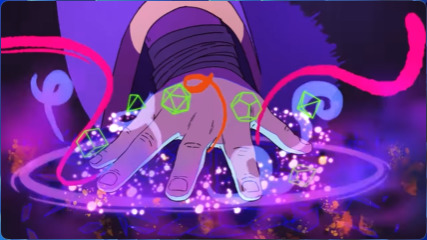
But this stops being a close up rather quickly, before it starts moving away. The shot just gives the hand context, and suddenly you aren't in an extreme close up of a hand, you are in a medium shot of a very large person. Then the camera pans backwards, and you can see villains and places spring up, although the perspective on Matt remains weird. Is he a few metres from you, or a hundred? How big is the Game Master here? There's a sense of mystery, of incomprehension. This is setting up some cosmic horror shenaniganry.

Then, we get Fearne. This is a wide camera motion, swivelling around her in a tracking shot that focuses on her face, and those eyes. It is like a reverse panorama, where Fearne is taking in the world, the world is observing Fearne.

But I want you to take note of the leaves here, because they are used to form a connection between her and Orym. The transition uses them, while it isn't a direct wipe transition (the leaf just flies close to mask an abrupt cut), it is framed as one. The name of that isn't important, though, what's important is the leaves. By being in both shots, they emphasise the relationship between the two characters. But where for Fearn they show off her sense of wonder, for Orym, they take on a very different meaning.
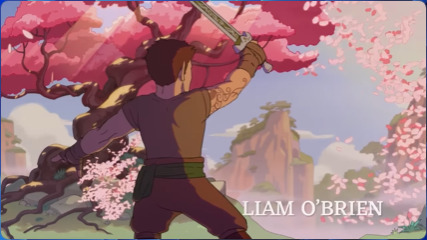
Notice, however, how still this shot is. There is no sense of danger here. This is a scene of a warrior with a sword and two people passing on from this world. But it's calm. Because this is a memory. Orym might not be at peace with the death, but the memory isn't a violent one, it's a memory of his family's lives.
Cut to a close up. Orym creates a gust of wind.
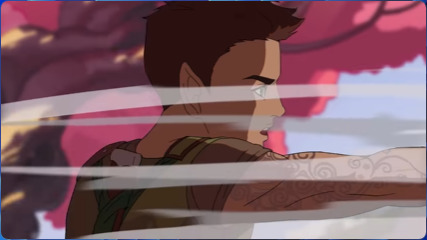
And cut to the next shot.
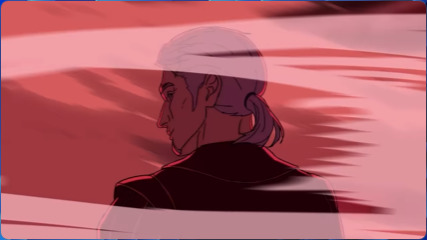
I will not lie, Bertrand is my favourite character across all of Critical Role, so this shot of him made me smile, but it isn't the point here. The point is Imogen's introduction.
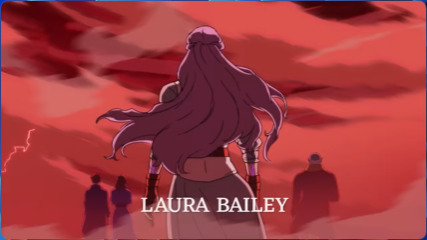
Although is Bertrand not actually the point? Because take a look at how Imogen is shown here. Do you notice anything?
She's shown in the exact same way. Imogen is shown doing the exact same thing that those who have died have done. And she can see them ahead of her. The camera panning back shows a wider perspective here, showing her as she tries to run, tries to get away from the same path as Bertrand.
The wind from Orym's blade that came to this scene gets across a consistent element: Memory. This is a dream. But dreams can become nightmares.
As Imogen loses her footing, the camera gives some of its wildest movements yet. It tumbles around her, then looks up.
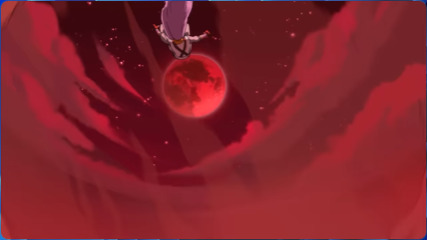
The camera stops moving when it sees the red moon, because now the viewer has something to orientate themselves around. There is a constant point, and we can see Imogen falling down. And getting closer, and closer, and closer, until.
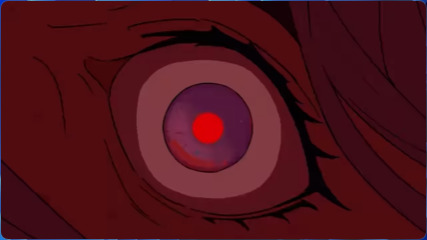
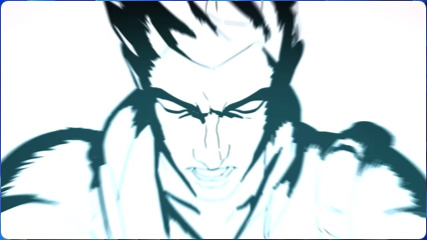

These are the three frames in order, there is nothing in between.
Imogen crashes into the screen, and we get an abrupt impact frame (that's the black and white one) then Ashton. This is so cool to watch, in my opinion, but it is quite possibly the opposite of smooth in camera work. So why is it so cool? Motion.
The motion is in towards Imogen and out away from Ashton. They are both falling, just in different directions. And the impact frame both helps smooth over and accentuate the abrupt transition.
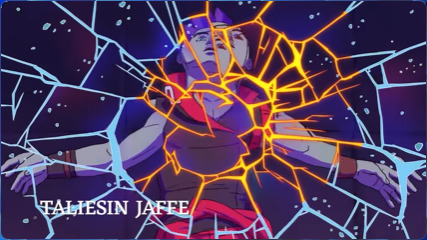
The camera around Ashton is a tracking shot. They are falling, but they remain the exact same in the screen (shrinking slightly). The rest of the world moves. And when Ashton lands, the screen cracks. The tracking shot is used to show Ashton's disassociation with their surroundings. Not in a "I feel nothing" type of way, but in a "it's me vs the world" type of way.

Then, there is an abrupt cut away. Nothing hides or smooths this at all, because Ashton's memory isn't smooth, and neither is Ashton. Remember the disassociating thing I mentioned, now it changes again to someone who gets lost in his thoughts. Medium.com calls this an "anxiety stare" and as someone who does that on the regular, I can attest to this abruptness being exactly what that feels like.

I'm not going to talk too much about the ship, but just be aware that there is a Dutch angle (the horison is diagonal) here to heighten the stress of it.

Likewise with this shot, there isn't much to talk about. The slow outward zoom and triangular composition are neat, and the tiered reactions (bottom row reacts, then middle, then Fearne) are amusing, but other than that, not much.
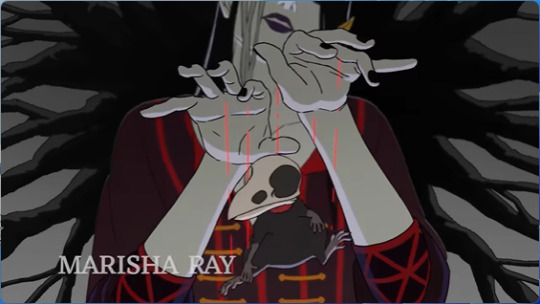
Then we meet Laudna, playing with Pate and giving him life. That's a neat little shot, I wonder if there's a metaphor there.

Oh.
This is a super cool visual because it establishes exactly who this character is in two seconds. But I also want to point out the symmetry of this. The hair becomes the blood which becomes the hair again, and then the tree.
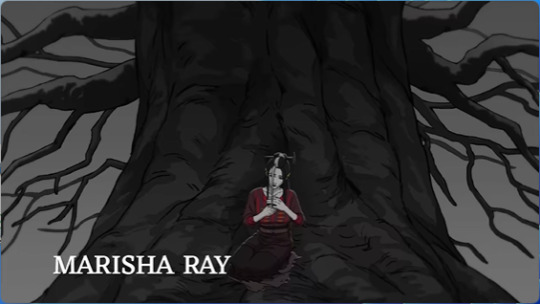
Laudna is introduced as big and scary and imposing, and that is very intentionally undercut by making her look small.
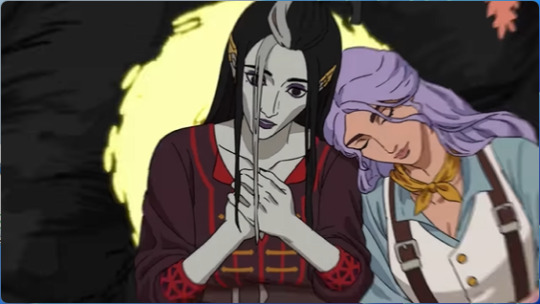
Being small means you are less likely to be the focal character, so shrinking Laudna takes away her agency. Only to give it back through Imogen, and when the camera pans back outwards, Laudna is the same size, but the colours and the surroundings make her feel less alone, and as a weird result of that, less small.
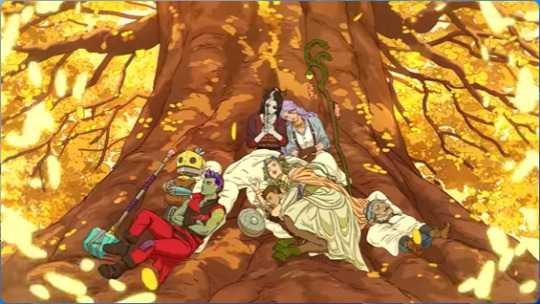
And last but not least in this moment, there is the delayed drop of the hands. Laudna finally feels safe and finally breathes a sigh of relief.

That, however, imediately match cuts to this. FCG's vision. The red tinting has obvious implications that I don't need to explain, but the match cut heavily implies a connection between this group and the Bells Hells. There is a fear that this might happen again made clear by a single transition.
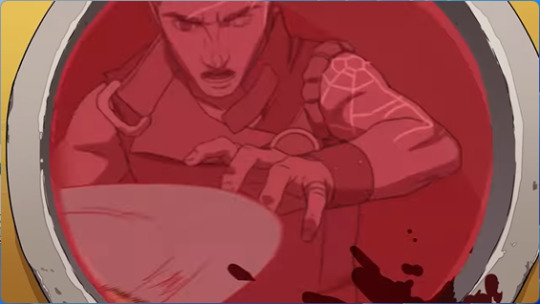

Here's something else. FCG doesn't move. At least, the camera doesn't treat them as moving. It's a slow panning out as if nothing is happening. It's the disassociation vibe that you get from Ashton's falling shots now repurposed to someone who isn't in control of their own actions. This is what FCG is afraid of, this is the important pieces of his character. This is FCG.
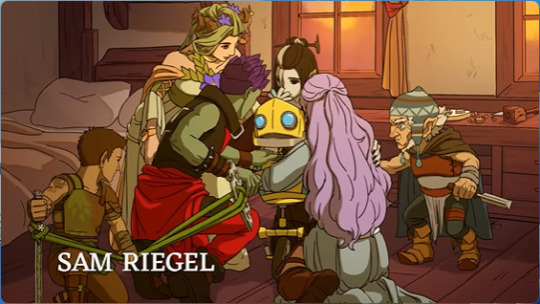
And just like Laudna, FCG finally gains agency when surrounded by their friends who hug them, and FCG finally moves.

Chetney Pock O'Pea, outlaw of the RTA, alpha of his own heart. A fundamentally chaotic character who takes rules as suggestions to be intentionally ignored. A man who's first instinct upon meeting you is to consider how you could be killed. And he is introduced whittling, with a steady camera and warm light illuminating his face. This is a peaceful side of Chetney, there is a duality to him.


Speaking of which, notice how Chetney draws back from the light as he transforms. His eyes begin to glow, but they don't illuminate him, until this:

Chetney is now backlit by the cold light of the moon itself (There's a neat reveal of Ruidus caused by the pan, but that's only tangentially relevant). Notice how much further you are from him here than in his first shot. But notice how much of him is visible, and how much of the screen he takes up. It's the same, this is still the same character. It's a true Doctor Jeckyl and Mr Hyde character. This isn't split personality, but a character who can be a different person in each form, while still remaining Chetney at all times.
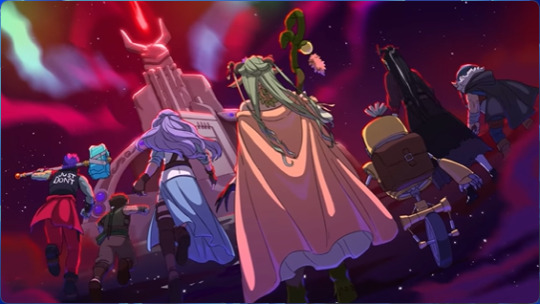
There is more in this video. I encourage you to watch it, but unfortunately, Tumblr has a limit on how many images I can include, so I will leave you with this final shot. A group of heroes looking up at a threat that is so much bigger than them, a threat that is literally controlling the light. But the Bells Hells are closer to the camera, they take up more of the screen. The battle isn't lost, instead, it is just starting.
#rants#literary analysis#literature analysis#media analysis#critrole#critical role#bells hells#imogen temult#laudna#ashton greymoore#fcg#orym of the air ashari#fearne calloway#chetney pock o'pea#its Thursday night#critical role bells hells
516 notes
·
View notes
Text

Quite literally the opposite of Donna Tartt's "Death is the mother of beauty[...]Beauty is terror. Whatever we call beautiful, we quiver before it."
#the secret history#tsh#tsh donna tartt#donna tartt#richard papen#francis abernathy#camilla macaulay#charles macaulay#bunny corcoran#henry winter#poetry#poems and poetry#poem#poems#dark academia#dark acadamia quotes#dark acadamia aesthetic#chaotic academia#chaotic academic aesthetic#aesthetic#kait rokowski#literature#classical literature#classics#classic literature#literary quotes#literary analysis
153 notes
·
View notes
Text
I was listening to Godhunter by the Aviators, and it got me thinking about Jim again. But specifically about what is provably the most creative kill of the series - his final stand against Bular. It was stunning visually and really good choreography wise, but it got me thinking about another fight involving Bular. One of the very first things we see in the entire franchise.
The fight between him and Kanjigar. And why I think Kanjigar wouldn't even think of doing what Jim did in that final battle. It's fascinating how differently both trollhunters use Daylight, and I have my thoughts on it to share.
Let's start with Kanjigar. As we see in Wizards, he was a warrior long before getting chosen by the amuket, and it's safe to say he has been trained in using a sword. And so even when he fights with Daylight he treats it pretty much the same as a regular blade.

Like over here. He burns himself to reach for the sword, when we know that Daylight can be teleported straight intk your palm. But it's not something Kanjigar would have had to use often because, as it's established, he is an excellent warrior. He probably is disarmed very rarely, if at all.
Not our Jim, though. He is a scrawny sixteen year old fighting giant creatures of living stone. The sword is flund from his hands constantly. And so he had to learn how to get it back in an instant or die. He is doing everything in his power to keep up with beings much stronger, bigger, and faster than he is, and so he is using this trick a lot.
So for him, the sword is much less of a physical thing, is what Im trying to say. And that allows him to come up with an idea for something like this:

Like he says in this scene, he is not a troll, and he doesn't fight like one. What a genius way to write a protagonist going against much more traditionally powerful opponents.
#literary analysis#trollhunters#tales of arcadia#jim lake jr#bular#bular the butcher#bular the vicious#he got two titles damn he is special like that#kanjigar#kanjigar the courageous
149 notes
·
View notes
Text
it's immediately clear that both the creature and victor find some of their greatest comforts in nature and that's one of the key features that connects them and proves they're not so different from each other, but i've also noticed that they tend to admire different TYPES of nature
victor tends to amaze at "the high and snowy mountains [...] immense glaciers [...] the rumbling thunder of the falling avalanche [...] the supreme and magnificent mont blonc" (65), typically finding the most comfort in the "savage and enduring scenes" (64) which tend to be colder and rougher yet unchanging; while the creature found that his "chief delights were the sight of the flowers, the birds, and all the gay apparel of summer" (94). there is probably something to be said about the creature's affinity for spring and summer, the seasons of rebirth, of NATURAL and beautiful life, a direct contrast to his unnatural, coldly scientific, "wretched" rebirth that he abhors so much
i was discussing this idea with a friend, who added that victor finding solace in the frozen and dead beauty of wintery environments, a typically less-favoured season, could reflect how victor often refuses himself the typical joys of life. throughout the novel, he struggles with his self-worth because of the guilt induced by his creation of the creature and the deaths that then followed, and the only reason he even desires peace and comfort is because he knows he needs to present himself that way to his family in order for them to be happy ("i [...] wished that peace would revisit my mind only that i might afford them consolation and happiness" [62]). i built on her idea by noting how the creature acknowledged that he "required kindness and sympathy; but [he] did not believe [him]self unworthy of it" (94), a completely contrasting stance from victor, who finds himself undeserving of the many comforts offered to him by his family
furthermore, it seems that victor finds beauty in glory & majesty ("[the scenery] spoke of a power mighty as Omnipotence--and i ceased to fear, or to bend before any being less almighty than that which had created and ruled the elements" [64]), while the creature finds beauty in warmth & growth. both characters seem to find what they desire(d) in the versions of the natural world that they admire most
to reference what i said in the beginning about the connections between victor and the creature, this observation only contributes to my understanding that victor and the creature are incredibly similar, and many of their identical traits involve a rejection or a reversal of the other; they both ardently wish for each other's destruction, they both ruined each other, they're the reason that the other is simultaneously a victim and a villain in their own sense, they both hate themselves but for reversed reasons (victor hates himself for what he's done rather than what he is, while the creature hates himself for what he is more than what he's done), and now this--they both find solace in nature, just opposing kinds. like father, like son
#if any of my friends see this#hiii#my apologies if i missed something crucial#i hope this makes sense. maybe it doesn't#maybe i didn't make any points at all! or maybe this is already well-known information#frankenstein#frankenstein the modern prometheus#mary shelley#mary shelly's frankenstein#classic lit#classic literature#gothic lit#gothic literature#frankenstein a new musical#literary analysis#victor frankenstein#frankenstein's monster#frankenstein's creature#adam frankenstein
477 notes
·
View notes